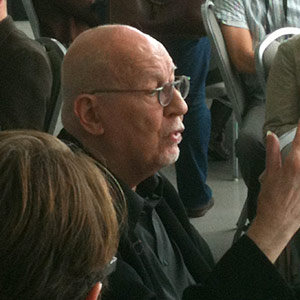Gravity Free: A Moment with George Lois
Mark Steinruck, Former User Experience Designer
Article Category:
Posted on
The 9th floor of the Spertus Institute was filled with circular tables draped in white tablecloths. In the middle of each table sat a sign with names like James Victore, Alex Lieu, and Brian Collins; each famous in their own fields of design. Groups of people poured out of the elevators and crowded around the tables to talk with their favorite designers. This was the scene last week in Chicago at the multidisciplinary Gravity Free design conference.
As I debated which table to join, a crowd quickly gathered in the back corner. Weaving through the maze of people and tables, I heard laughter from the circle of people that surrounded the table. Clearly this was the place to be, so I took my place in the standing room only crowd. On one side of the table sat an older man. His circular stainless steel framed glasses and sharp black suit sharply contrasted his otherwise grandfatherly look. The crowd hung on every word of the stories that he told in a thick Bronx accent. This table certainly was special, because the sign on the table read George Lois.
 The theme of the 2012 Gravity Free conference was Outlaws & Icons. Many of the presenters fit into one, or both, of those categories. But George Lois has secured spots near the top of both lists. His lifetime of work challenged culture and changed minds during a pivotal time in American history. In the 1960s, Lois designed some of the most controversial covers of Esquire magazine. Under the editorial leadership of Howard Hayes, he is credited in part for increasing the magazine subscriber base from 400,000 to over 1,000,000. Everyone wanted to get close enough to hear him speak, and even CBS showed up with a camera crew.
The theme of the 2012 Gravity Free conference was Outlaws & Icons. Many of the presenters fit into one, or both, of those categories. But George Lois has secured spots near the top of both lists. His lifetime of work challenged culture and changed minds during a pivotal time in American history. In the 1960s, Lois designed some of the most controversial covers of Esquire magazine. Under the editorial leadership of Howard Hayes, he is credited in part for increasing the magazine subscriber base from 400,000 to over 1,000,000. Everyone wanted to get close enough to hear him speak, and even CBS showed up with a camera crew.
Leaning forward, Lois peered over the top of his thick glasses and recounted the events that led to the creation of the “I want my MTV!” slogan in 1982. “I told them that we’d get Mick Jagger to do the commercial. They said it would never work.” At a time when the network was struggling to get cable networks to include MTV in the lineup, it was Lois who rebranded the network causing it to soar in popularity. “I called Mick and talked for three minutes. I finally stopped and said, ‘Mick, you there?’” “Yeah, yeah...keep going,” Jagger replied. Lois slumped back in his chair with a look of amazement as he remembered Jagger saying, “I’ll be in New York next week. Where do you want me?” Lois continued, “He came to the studio an hour late, we shot the commercial with Mick picking up the phone saying, ‘I want my MTV!’, and that’s how it all started.” He finished with a broad smile that only comes from telling a story that will never get old.
The hour disappeared with Lois telling one story after another. Every so often he would stop mid-thought and offer a piece of sage wisdom from working at his craft for so many years.
- “Create big ideas, not designs.”
- “There's no such thing as a cautious creative.”
- “The word comes first, then the big idea.”
- “Never work for bad people. If you do, you're mediocre.”
- “Designers don't need to learn how to design. They need to learn how to sell their ideas.”
- “Present your ideas without saying ‘yeah’, ‘like’, and ‘um’ every other the word.”
- “You can't let anybody make you do bad work.”
In the end, this polarizing figure in the world of advertising sold me. Lois sold me on his work, his big ideas, and himself. I left Gravity Free feeling energized about my own work, and excited to learn more about Lois. I realized that I’m guilty of focusing solely on studying web design because that’s what I do day-to-day. The principles of good design are ubiquitous and translate to every design discipline including the web. Big ideas are still out there. The opportunity to be unique isn't dead. Go do good work for good people and avoid mediocrity at every cost.